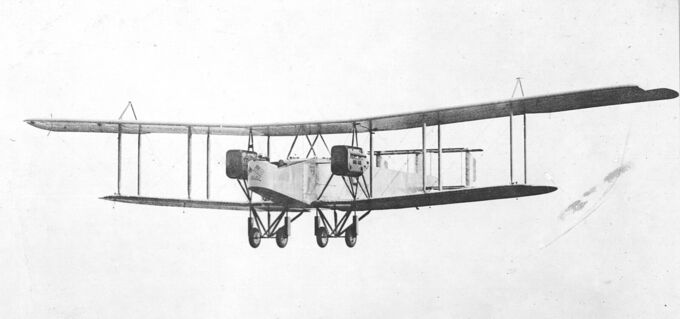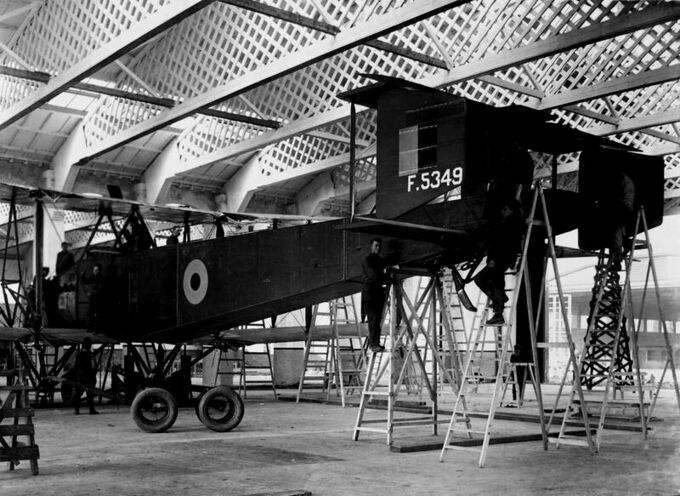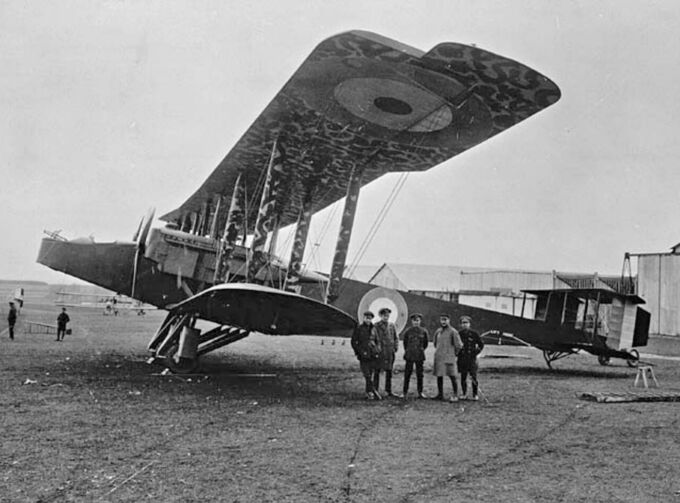The Handley Page Type O was a British heavy bomber developed during the First World War and one of the first aircraft designed specifically for long-range strategic bombing. Built to meet the Royal Navy’s need for a large bomber capable of reaching targets deep inside enemy territory, the Type O was one of the largest aircraft in the world when built and laid the groundwork for the future of bomber design.
Design, Development And Variants:
Work on the Type O began in 1915 under Sir Frederick Handley Page. The goal was to create a twin-engine aircraft that could carry a heavy bomb load over long distances, while maintaining flight stability and ease of control, especially during night operations.
The first version, the O/100, also known as the H.P.11, was a large, twin-engine biplane featuring a wingspan of over 100 feet (30.5 meters), powered by two Rolls-Royce Eagle engines. It had a wooden frame with fabric covering, a typical construction approach of the time. Defensive armament included up to five Lewis machine guns placed in nose, dorsal, and beam positions.
The aircraft prioritized range and payload over speed and agility. It had a maximum speed of around 97 mph (156 km/h) and could carry up to 1,800 lbs (816 kg) of bombs — a considerable load for the period. In 1917, the O/100 began flying night bombing missions over Belgium, targeting railway yards, industrial centers, and submarine bases. Its successor, the O/400, also known as the H.P.12, entered service in 1918 with stronger engines and improved payload capacity, becoming the RAF’s standard heavy bomber during the final months of the war.
Variants:
- O/100: The original production model, powered by two Rolls-Royce Eagle II engines. It featured a three-bay wing and had a bomb load of up to 1,650 lbs. Four prototypes and 42 production aircraft were built.
- O/400: The improved and most widely produced version. Equipped with more powerful Rolls-Royce Eagle VIII engines, it had a reinforced airframe, simplified fuel system, and increased payload capacity. 554 aircraft were built before the war’s end.
A third variant, the V/1500, was developed as a much larger strategic bomber capable of reaching Berlin, but it saw only limited service after the armistice. Sources differ as to the actual number completed, but they vary between 32 and 40 aircraft.
Operational History:
Initially used for daylight attacks over the North Sea, the O/100s, the first model to reach combat, transitioned to night bombing raids over German-occupied Belgium and France. These missions targeted key military infrastructure, including railway stations, airfields and naval facilities. The first significant bombing operation by the Handley Page Type O occurred on the night of 16 March 1917, when a single O/100 from No. 7A Squadron of the Royal Naval Air Service attacked a railway junction at Moulins-lès-Metz in German-occupied France. This marked one of the first uses of a heavy bomber for long-range, nighttime operations.
On the night of 16/17 August of 1917, 14 O/100s were employed in a series of bombing raids targeting the Thourout railway junction in Belgium, a key transport hub for German reinforcements during the Third Battle of Ypres. The raids were designed to disrupt enemy logistics and hinder the movement of troops and supplies. During the same period, the O/100 also participated in anti-submarine patrols over the North Sea attacking U-boats, though no submarines were reported sunk.
The Handley Page Type O also saw action against the Ottoman Empire. During a night raid on 10 July 1917, the battlecruiser SMS Goeben (called Yavuz Sultan Selim in Ottoman service) was attacked by eight 112 lb bombs and an S138-class torpedo boat named Yadigar-i Millet was sunk. The crew then bombed the SS General and dropped two bombs on the Ottoman War Office building before returning.
In 1918, the improved Handley Page O/400 became the main variant used in combat. It played a role in the newly formed Independent Air Force, which focused on long-range strategic bombing missions into Germany without coordination with the Army or the Navy. A considerable portion of the Independent Air Force’s efforts was in tactical support of the Allied armies and the war ended before the IAF could conduct any sustained strategic bombing. But whilst attacks of this type were generally unsuccessful, the principle of deep penetration bombing raids against strategic targets was established.
The O/400s carried out significant raids on German cities, including Mannheim, Saarbrücken and Cologne, targeting industrial sites, railway networks and other military infrastructure. A notable raid took place on the night of 21/22 October 1918, when four Handley Pages attacked Kaiserslautern with heavy bombs and incendiary bombs. The city was attacked again on 23/24 October, along with Koblenz, Mannheim and Wiesbaden.
After the armistice, the Handley Page Type O was gradually retired from frontline military service as newer and more advanced bombers became available. However, the aircraft did not disappear entirely. A number of surviving O/400s were repurposed for non-combat roles, particularly in the emerging field of civil aviation.
Recognizing the aircraft’s large size and payload capacity, Handley Page Ltd. began converting surplus bombers into makeshift passenger aircraft. These conversions typically involved enclosing the bomb bay and fuselage to accommodate up to 12 passengers, a remarkable innovation at the time. One such aircraft, operated by Handley Page Transport Ltd., flew the first ever airliner service between London and Paris in 1919 as part of the early European commercial aviation network.
In military contexts, some O/400s remained in use briefly as trainers and transport aircraft in the early years of the Royal Air Force. Others were sold to foreign governments; for example, a small number were exported to countries like China, India, and Japan for evaluation or training purposes.




